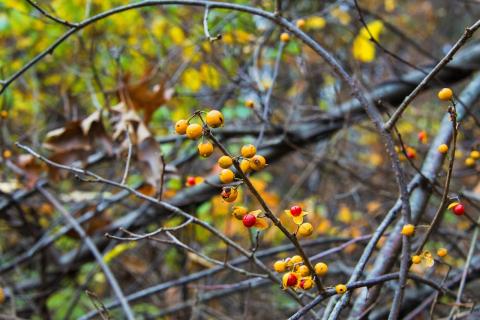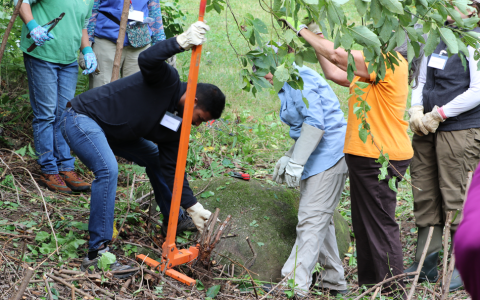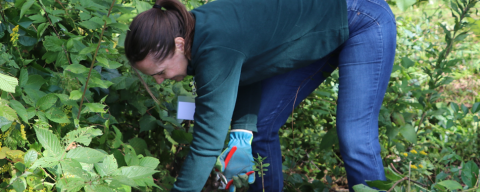Dealing with Invasive Species: Pick Your Battles
Japanese Knotweed is filling the roadsides leading up to your house. Garlic mustard has begun along the paths you walk in the forest. Multiflora rose has spread along the river. Now that you know more about invasive species, you can see them all around you. But how can you deal with them all? Where do you even start? What is the best method to use? The key to beginning is to pick your battles. Focus in on the most impactful area and make a plan.
To review, we know that an invasive plant is termed invasive when it is not native to a region and is likely to have an economic, environmental, or human health impact. The second half of that definition is what differentiates an invasive plant from other non-native plants. The beautiful common lilac (Syringa vulgaris) is the state flower of New Hampshire but is a non-native plant. It originally comes from Southeast Asia. However, they do not spread quickly or overwhelm the local system.

Oriental bittersweet (Celastrus orbiculatus) however, is a non-native plant that not only proliferates easily but strangles trees that it wraps around and can bring them down, causing environmental harm – thus an invasive plant.
Invasives are highly adaptable plants that have various methods to gain the upper hand in resource competition. They tend to leaf out earlier than native plants to catch the sun first and extend their growing season well into the fall. They may be allelopathic and produce a chemical that inhibits growth of other plants nearby. Some produce seeds that remain viable in the soil for up to a decade, just waiting for the optimal conditions to sprout again. Or they cover an area so densely, native plants can no longer grow there. In wetlands, purple loosestrife (Lythrum sailcaria) can grow so thickly that ducks and turtles can’t swim through. They have also escaped their natural predators and pathogens that they evolved with in their native habitat. Reduced impacts from disease and herbivory gives them another advantage over native species.
Due to their adaptability to a range of environments, invasive species are difficult to eliminate once they have taken root. And because there are so many in multiple areas, it can be overwhelming to contemplate eradicating them successfully. That is where focusing on one area or species and having a plan can make a daunting task manageable.
Whether at home or as a community project, your first step is to identify the species you are dealing with. Make sure you can recognize the plant, differentiate it from others that may surround or be among it, and know the best steps to use in removing it.
Then you need to prioritize. What is it you want to accomplish? Sometimes it is best to simply prevent the spread of an invasive into a new area. You can’t control landscapes around the area you have chosen, but you can do your best to manage an area where that species of invasive has not yet established itself and remove any outliers looking to start a colony. Perhaps you are looking to protect critically sensitive natural resources, such as animal habitats or an ecosystem that requires a variety of native plants to thrive. Or you wish to preserve landscape features that provide ecological services for people, such as a waterway.
These priorities and management goals come particularly into play when you are looking to focus on an area beyond your own property. With invasives everywhere throughout a town or region, what do you focus on? Your best bet is to either to keep out invasives that have not yet arrived in force, or work on reducing “hot spots” – dense congregations of invasive species in sensitive areas. When working outside of your own property, always check with your local conservation commission to see if any invasive removal projects are already planned near you. You can also check out Nature Groupie for group invasive removal projects throughout the state.
On a personal level, I looked up my own town of Nashua, where I found the plants that are “Most Wanted” to be kept out of the area (they have begun to make appearances in the area, but there are no large groupings) are blunt-leaved privet (Liqustrum obtusifolium), Dame’s rocket (Hesperis matronalis) and garlic mustard (Alliaria petiolata). Having studied and created a full poster on garlic mustard for the Natural Resources Stewards class, I was able to easily identify it. It is a plant that is easy to pull from the ground with roots and bag as well. And there were spots in Nashua where I had seen it starting to take hold, as in Mine Falls Park. Thus the priority of preventing the spread of invasives to new areas was a project I could easily take on. This is a form of Early Detection Rapid Response (EDRR), which is the most effective form of control outside of prevention.
Garlic mustard is easy to remove mechanically, as it can be pulled up by hand, roots and all. However, this does not mean that it is easy to eradicate in one sitting. Garlic mustard seeds can stay viable in the soil for ten years, so any area earmarked with garlic mustard plants must be monitored for new growth on a regular basis in the ensuing years. This is the long-term commitment for early detection and rapid response.
When removing invasives by hand (a mechanical treatment) pull the plants with their roots intact onto an impervious surface such as flat asphalt or a black plastic sheet to bake in the sun for several weeks before disposing in the trash. This ensures that the seeds or stalks of the plant are no longer viable, and will not simply spread to and sprout up where you have disposed of them.

You can suffocate seedlings by covering them with plastic sheeting for a few years or more. This will kill every herbaceous plant you cover, so be prudent! Some species (albeit NOT Japanese knotweed!) can be eradicated if you can commit to mowing the area several times a year for up to five years. At first the plant will produce more shoots, as plants are prone to do from pruning, but eventually they will weaken and die. If the mowing stops too early or is not done regularly enough, the plants will return, perhaps in even greater numbers. This too would be an ongoing management plan.
If you are dealing with a larger or more mature invasive population, a chemical treatment might be more feasible and effective. However, this does come with restrictions. If it is not your property, you must have a pesticide applicator license to apply treatments or hire a licensed applicator to do the job. As a volunteer you cannot apply chemical treatments to any property other than your own (and if you do use chemicals, you must follow the instructions on the label). If you live near a water source, check with your town for permitting as well.
A foliar spray treatment is applied to the leaves of a plant. It is most effective in late fall, when plants are busy moving photosynthetic material from the leaves to the roots, as it will bring the herbicide right down to the roots. However, the plants must be fully leafed out for the treatment to be most effective.
A more precise method is the cut-stump method. This is a hybrid of mechanical and chemical treatment, as the invasive woody plant is cut down, and then herbicide is applied directly to the stump. This results in less opportunity for herbicide to impact any non-target plants, while still being effective on woody shrubs or trees.
Identification, prioritization, executing a plan and long-term follow-up are all important to managing invasive species. Without a multi-year commitment, the plants will soon return. Remember to Remove and Restore as well. Any time you pull up lots of invasives and leave bare, disturbed earth, replace them with native plants that can take hold in that soil and prevent invasives from returning. If you’d like to learn more about planning invasive plant management projects, check out the Picking Our Battles Guide at the NH Fish and Game website that goes into greater depth on all of the topics discussed here. It is the source material for this article and provides a wealth of information and resources.
https://extension.unh.edu/sites/default/files/migrated_unmanaged_files/Resource005539_Rep7725.pdf

